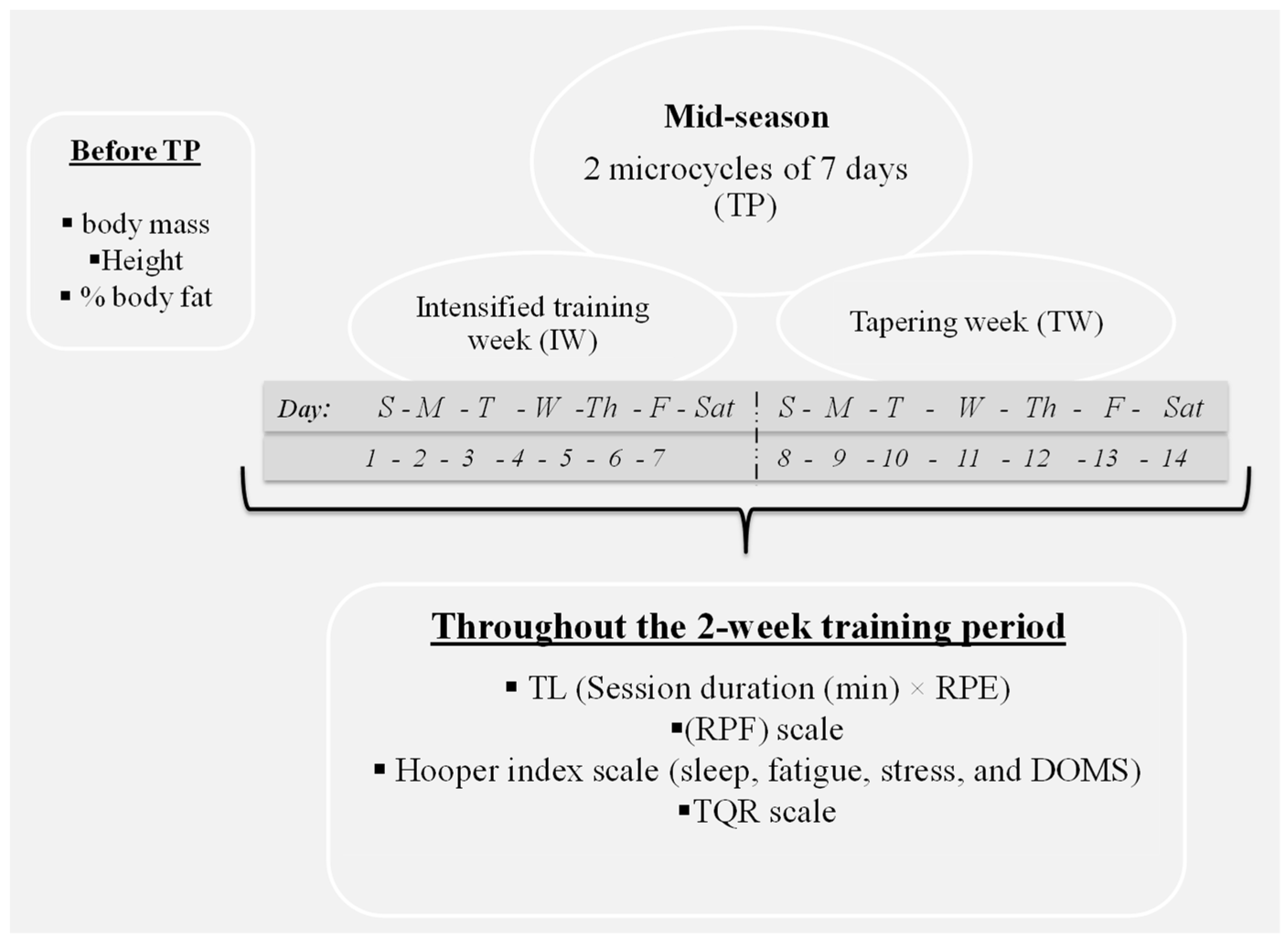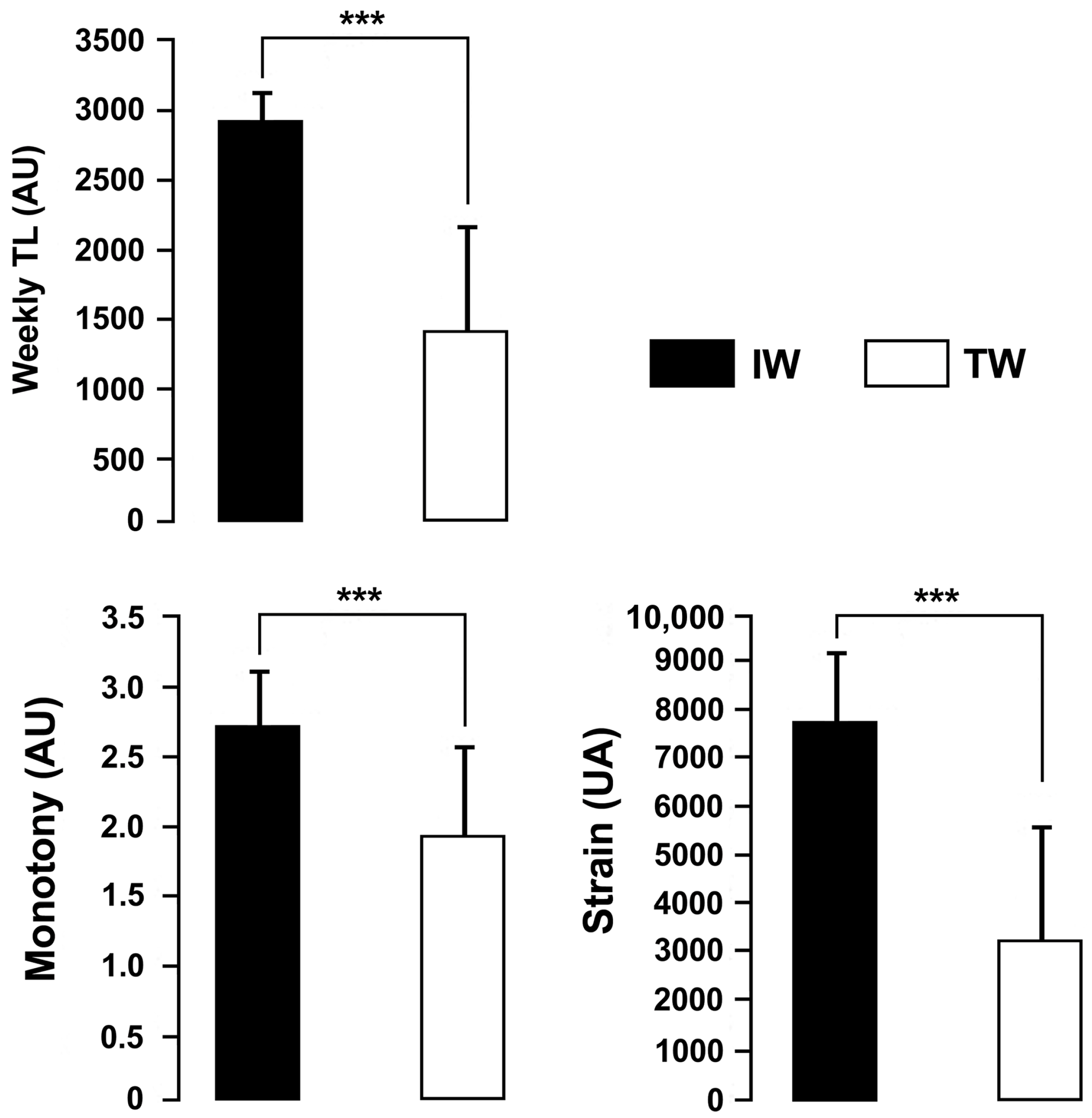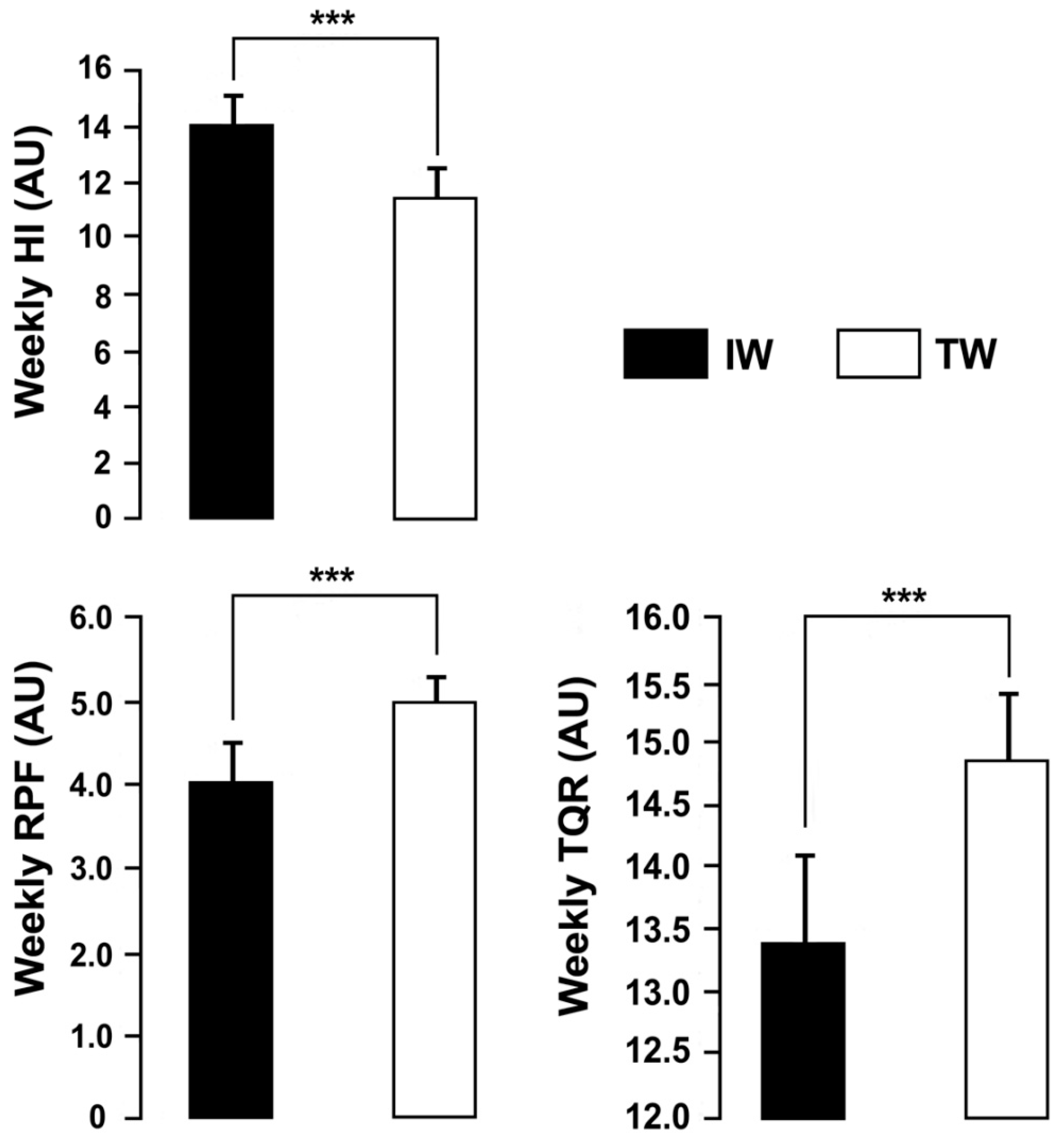A Practical Approach to Assessing Physical Freshness: Utility of a Simple Perceived Physical Freshness Status Scale
Abstract
:1. Introduction
2. Materials and Methods
2.1. Experimental Approach to the Problem
2.2. Participants
2.3. Procedure
2.4. Measures
2.4.1. Scales to Assess Physical Freshness, Well-Being, and Recovery States
2.4.2. Rating of Physical Freshness (RPF)
2.4.3. Well-Being Indices (Hooper Index)
2.4.4. Total Quality of Recovery (TQR)
2.4.5. Rating of Perceived Exertion (RPE)
2.4.6. Training Load Monitoring
2.4.7. Statistical Analysis
3. Results
4. Discussion
5. Conclusions
Author Contributions
Funding
Institutional Review Board Statement
Informed Consent Statement
Data Availability Statement
Acknowledgments
Conflicts of Interest
References
- Ouergui, I.; Franchini, E.; Selmi, O.; Levitt, D.E.; Chtourou, H.; Bouhlel, E.; Ardigò, L.P. Relationship between perceived training load, well-being indices, recovery state and physical enjoyment during judo-specific training. Int. J. Environ. Public Health 2020, 17, 7400. [Google Scholar] [CrossRef]
- Selmi, O.; Ouergui, I.; Castellano, J.; Levitt, D.; Bouassida, A. Effect of an intensified training period on well-being indices, recovery, and psychological aspects in professional soccer players. Eur. Appl. Psychol. 2020, 70, 100603. [Google Scholar] [CrossRef]
- Clemente, F.M.; Mendes, B.; Nikolaidis, P.T.; Calvete, F.; Carriço, S.; Owen, A.L. Internal training load and its longitudinal relationship with seasonal player wellness in elite professional soccer. Physiol. Behav. 2017, 179, 262–267. [Google Scholar] [CrossRef]
- Moalla, W.; Fessi, M.S.; Farhat, F.; Nouira, S.; Wong, D.P.; Dupont, G. Relationship between daily training load and psychometric status of professional soccer players. Res. Sports Med. 2016, 24, 387–394. [Google Scholar] [CrossRef]
- Selmi, O.; Ouergui, I.; Levitt, D.E.; Marzouki, H.; Knechtle, B.; Nikolaidis, P.T.; Bouassida, A. Training, psychometricstatus, biological markers and neuromuscular fatigue in soccer. Biol. Sport 2021, 39, 319–327. [Google Scholar] [CrossRef]
- Clemente, F.M.; Martinho, R.; Calvete, F.; Mendes, B. Training load and well-being status variations of elite futsal players across a full season: Comparisons between normal and congested weeks. Physiol. Behav. 2019, 201, 123–129. [Google Scholar] [CrossRef]
- Nobari, H.; Aquino, R.; Clemente, F.M.; Khalafi, M.; Adsuar, J.C.; Pérez-Gómez, J. Description of acute and chronic load, training monotony and strain over a season and its relationships with well-being status: A study in elite under-16 soccer players. Physiol. Behav. 2020, 225, 113117. [Google Scholar] [CrossRef]
- Fessi, M.S.; Nouira, S.; Dellal, A.; Owen, A.; Elloumi, M.; Moalla, W. Changes of the psychophysical state and feeling of wellness of professional soccer players during pre-season and in-season periods. Res. Sports Med. 2016, 24, 375–386. [Google Scholar] [CrossRef]
- Mendes, B.; Palao, J.M.; Silvério, A.; Owen, A.; Carriço, S.; Calvete, F.; Clemente, F.M. Daily and weekly training load and wellness status in preparatory, regular and congested weeks: A season-long study in elite volleyball players. Res. Sports Med. 2018, 26, 462–473. [Google Scholar] [CrossRef]
- Clemente, F.M.; Silva, A.F.; Clark, C.C.; Conte, D.; Ribeiro, J.; Mendes, B.; Lima, R. Analyzing the seasonal changes and relationships in training load and wellness in elite volleyball players. Int. J. Sports Physiol. Perform. 2020, 15, 731–740. [Google Scholar] [CrossRef]
- Brink, M.S.; Nederhof, E.; Visscher, C.; Schmikli, S.L.; Lemmink, K.A. Monitoring load, recovery, and performance in young elite soccer players. J. Strength Cond. Res. 2010, 24, 597–603. [Google Scholar] [CrossRef] [Green Version]
- Selmi, O.; Gonçalves, B.; Ouergui, I.; Levitt, D.E.; Sampaio, J.; Bouassida, A. Influence of Well-Being Indices and Recovery State on the Technical and Physiological Aspects of Play During Small-Sided Games. J. Strength Cond. Res. 2019, 35, 2802–2809. [Google Scholar] [CrossRef]
- Bafirman, B. Analysis of Nutritional Status and Quality of Physical Fitness in Health and Sport Physical Education Learning Outcomes Toward Pupil of Elementary School in Padang. Glob. J. Interdiscip. Soc. Sci. 2014, 3, 103–107. [Google Scholar]
- Harriss, D.J.; MacSween, A.; Atkinson, G. Ethical standards in sport and exercise science research: 2020 update. Int. J. Sports Med. 2019, 40, 813–817. [Google Scholar] [CrossRef] [Green Version]
- Durnin, J.V.; Womersley, J.V.G.A. Body fat assessed from total body density and its estimation from skinfold thickness: Measurements on 481 men and women aged from 16 to 72 years. Br. J. Nutr. 1974, 32, 77–97. [Google Scholar] [CrossRef] [Green Version]
- Nobari, H.; Fani, M.; Pardos-Mainer, E.; Pérez-Gómez, J. Fluctuations in well-being based on position in elite young soccer players during a full season. Healthcare 2021, 9, 586. [Google Scholar] [CrossRef]
- Kenttä, G.; Hassmén, P. Overtraining and recovery. Sports Med. 1998, 26, 1–16. [Google Scholar] [CrossRef]
- Foster, C.; Florhaug, J.A.; Franklin, J.; Gottschall, L.; Hrovatin, L.A.; Parker, S.; Dodge, C. A new approach to monitoring exercise training. J. Strength Cond. Res. 2001, 15, 109–115. [Google Scholar]
- Hooper, S.L.; Mackinnon, L.T. Monitoring overtraining in athletes. Sports Med. 1995, 20, 321–327. [Google Scholar] [CrossRef]
- Nobari, H.; Alves, A.R.; Clemente, F.M.; Perez-Gomez, J.; Clark, C.C.; Granacher, U.; Zouhal, H. Associations between variations in accumulated workload and physiological variables in young male soccer players over the course of a season. Front. Physiol. 2021, 12, 233. [Google Scholar] [CrossRef]
- Impellizzeri, F.M.; Rampinini, E.; Coutts, A.J.; Sassi, A.L.D.O.; Marcora, S.M. Use of RPE-based training load in soccer. Med. Sci. Sports Exerc. 2004, 36, 1042–1047. [Google Scholar] [CrossRef]
- Selmi, O.; Marzouki, H.; Ouergui, I.; BenKhalifa, W.; Bouassida, A. Influence of intense training cycle and psychometric status on technical and physiological aspects performed during the small-sided games in soccer players. Res. Sports Med. 2018, 26, 401–412. [Google Scholar] [CrossRef]
- Foster, C. Monitoring training in athletes with reference to overtraining syndrome. Med. Sci. Sports Exerc. 1998, 30, 1164–1168. [Google Scholar] [CrossRef]
- Hopkins, W.; Marshall, S.; Batterham, A.; Hanin, J. Progressive statistics for studies in sports medicine and exercise science. Med. Sci. Sports Exerc. 2009, 41, 3. [Google Scholar] [CrossRef] [Green Version]
- Cohen, J. Statistical Power Analysis for the Behavioral Sciences, 2nd ed.; Lawrence Erlbaum Associates Inc.: Hillsdale, NJ, USA, 1988; Volume 13. [Google Scholar]
- Buchheit, M.; Racinais, S.; Bilsborough, J.C.; Bourdon, P.C.; Voss, S.C.; Hocking, J.; Coutts, A.J. Monitoring fitness, fatigue and running performance during a pre-season training camp in elite football players. J. Sci. Med. Sport 2013, 16, 550–555. [Google Scholar] [CrossRef]
- Suzuki, K. Recent Progress in Applicability of Exercise Immunology and Inflammation Research to Sports Nutrition. Nutrients 2021, 13, 4299. [Google Scholar] [CrossRef]



| Time of Training | Duration (min) | RPE | Session-TL (AU) | Daily-TL (AU) | ||
|---|---|---|---|---|---|---|
| Intensified week (IW) | Sunday | 15.00 h | 75 | 3.4 ± 0.6 | 257.8 ± 47.2 | 257.8 ± 47.2 |
| Monday | 9.00 h | 70 | 4.4 ± 0.5 | 310.6 ± 35.8 | 565.6 ± 45.6 | |
| 16.00 h | 85 | 3.0 ± 0.2 | 255.0 ± 2.2 | |||
| Tuesday | 9.00 h | 75 | 5.4 ± 0.8 | 407.8 ± 6.1 | 739.3 ± 84.8 | |
| 16.00 h | 90 | 3.6 ± 0.8 | 331.8 ± 7.4 | |||
| Wednesday | 15.00 h | 95 | 5.8 ± 0.9 | 558.1 ± 84.1 | 558.1 ± 84.1 | |
| Thursday | 15.00 h | 70 | 4.9 ± 0.8 | 345.6 ± 54.1 | 345.6 ± 54.1 | |
| Friday | 15.00 h | 75 | 5.4 ± 0.7 | 407.8 ± 72.2 | 407.8 ± 72.2 | |
| Saturday | Rest | 00 | 00 | 00 | 00 | |
| Weekly-TL (AU) | 2874.7 | |||||
| Monotony (AU) | 2.0 | |||||
| Strain (AU) | 7885.1 | |||||
| Taper week (TW) | Sunday | 16.00 h | 55 | 3.1 ± 0.5 | 168.4 ± 30.5 | 168.4 ± 30.5 |
| Monday | 15.00 h | 75 | 3.6 ± 0.6 | 271.9 ± 44.9 | 271.9 ± 44.9 | |
| Tuesday | 15.00 h | 85 | 3.6 ± 0.6 | 302.8 ± 51.7 | 302.8 ± 51.7 | |
| Wednesday | 15.00 h | 70 | 3.2 ± 0.5 | 223.1 ± 36.8 | 223.1 ± 36.8 | |
| Thursdays | 15.00 h | 40 | 2.4 ± 0.6 | 95.0 ± 23.9 | 95.0 ± 23.9 | |
| Friday | 15.00 h | 56 | 4.3 ± 2.4 | 307.5 ± 220.8 | 307.5 ± 220.8 | |
| Saturday | Rest | 00 | 00 | 00 | 00 | |
| Weekly-TL (AU) | 1337.2 | |||||
| Monotony (AU) | 1.8 | |||||
| Strain (AU) | 2512.4 | |||||
| Perceived Physical Freshness Status |
|---|
| 1-Very, very poor freshness |
| 2-Very poor freshness |
| 3-Poor freshness |
| 4-Moderate freshness |
| 5-Good freshness |
| 6-Very good freshness |
| 7-Very, very good freshness |
| Intensified Week (IW) | Tapering Week (TW) | |
|---|---|---|
| Training sessions | 7 | 5 |
| Training days | 5 | 5 |
| Match days per week | 1 (friendly) | 1 (official) |
| Rest days | 1 | 1 |
| Average weekly TL (AU) | >2500 | <1500 |
| Sleep | Stress | Fatigue | DOMS | HI | TQR | TL | |||
|---|---|---|---|---|---|---|---|---|---|
| Daily RPF TP | r | −0.30 ** | −0.25 ** | −0.78 ** | −0.79 ** | −0.84 ** | 0.82 ** | −0.75 ** | |
| 95%CL | Lower | −0.43 | −0.39 | −0.84 | −0.85 | −0.90 | 0.76 | −0.81 | |
| Upper | −0.16 | −0.11 | −0.71 | −0.72 | −0.77 | 0.88 | −0.70 | ||
| Daily RPF IW | r | −0.29 ** | −0.15 | −0.72 ** | −0.71 ** | −0.81 ** | 0.81 ** | −0.66 ** | |
| 95%CL | Lower | −0.44 | −0.34 | −0.82 | −0.82 | −0.91 | 0.71 | −0.76 | |
| Upper | −0.11 | −0.06 | −0.62 | −0.59 | −0.68 | 0.90 | −0.56 | ||
| Daily RPF TW | r | −0.20 * | −0.23 * | −0.72 ** | −0.76 ** | −0.78 ** | 0.75 ** | −0.70 ** | |
| 95%CL | Lower | −0.42 | −0.44 | −0.88 | −0.84 | −0.88 | 0.60 | −0.80 | |
| Upper | 0.03 | −0.02 | −0.60 | −0.67 | −0.66 | 0.85 | −0.58 | ||
Publisher’s Note: MDPI stays neutral with regard to jurisdictional claims in published maps and institutional affiliations. |
© 2022 by the authors. Licensee MDPI, Basel, Switzerland. This article is an open access article distributed under the terms and conditions of the Creative Commons Attribution (CC BY) license (https://creativecommons.org/licenses/by/4.0/).
Share and Cite
Selmi, O.; Levitt, D.E.; Clemente, F.M.; Nobari, H.; My, G.; Muscella, A.; Suzuki, K.; Bouassida, A. A Practical Approach to Assessing Physical Freshness: Utility of a Simple Perceived Physical Freshness Status Scale. Int. J. Environ. Res. Public Health 2022, 19, 5836. https://doi.org/10.3390/ijerph19105836
Selmi O, Levitt DE, Clemente FM, Nobari H, My G, Muscella A, Suzuki K, Bouassida A. A Practical Approach to Assessing Physical Freshness: Utility of a Simple Perceived Physical Freshness Status Scale. International Journal of Environmental Research and Public Health. 2022; 19(10):5836. https://doi.org/10.3390/ijerph19105836
Chicago/Turabian StyleSelmi, Okba, Danielle E. Levitt, Filipe Manuel Clemente, Hadi Nobari, Giulia My, Antonella Muscella, Katsuhiko Suzuki, and Anissa Bouassida. 2022. "A Practical Approach to Assessing Physical Freshness: Utility of a Simple Perceived Physical Freshness Status Scale" International Journal of Environmental Research and Public Health 19, no. 10: 5836. https://doi.org/10.3390/ijerph19105836
APA StyleSelmi, O., Levitt, D. E., Clemente, F. M., Nobari, H., My, G., Muscella, A., Suzuki, K., & Bouassida, A. (2022). A Practical Approach to Assessing Physical Freshness: Utility of a Simple Perceived Physical Freshness Status Scale. International Journal of Environmental Research and Public Health, 19(10), 5836. https://doi.org/10.3390/ijerph19105836












